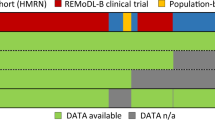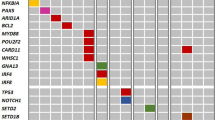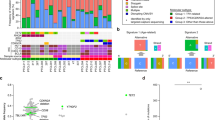Abstract
Follicular lymphoma (FL) with a t(14;18) is a B-cell neoplasm clinically characterized by multiple recurrencies. In order to investigate the clonal evolution of this lymphoma, we studied paired primary and relapse tumor samples from 33 patients with recurrent non-transformed t(14;18)-positive FL. We reconstructed phylogenetic trees of the evolution by taking advantage of the activation-induced cytidine deaminase (AID)-mediated somatic hypermutation (SHM) active in the germinal center reaction using sequences of the clonal VHDHJH rearrangements of the immunoglobulin heavy chain (IGH) locus. Mutational analysis of the IGH locus showed evidence for ongoing somatic mutation and for counter-selection of mutations affecting the BCR conformation during tumor evolution. We further followed evolutionary divergence by targeted sequencing of gene loci affected by aberrant SHM as well as of known driver genes of lymphomagenesis, and by array-based genome-wide chromosomal imbalance and DNA methylation analysis. We observed a wide spectrum of evolutionary patterns ranging from almost no evolution to divergent evolution within recurrent non-transformed t(14;18) FL. Remarkably, we observed a correlation of the magnitude of evolutionary divergence across all genetic and epigenetic levels suggesting co-evolution. The distribution of coding mutations in driver genes and the correlation with SHM suggest CREBBP and AID to be potential modifiers of genetic and epigenetic co-evolution in FL.
This is a preview of subscription content, access via your institution
Access options
Subscribe to this journal
Receive 12 print issues and online access
$259.00 per year
only $21.58 per issue
Buy this article
- Purchase on Springer Link
- Instant access to full article PDF
Prices may be subject to local taxes which are calculated during checkout




Similar content being viewed by others
References
Swerdlow SH, Campo E, Harris NL, Jaffe ES, Pileri SA, Stein H et al. WHO Classification of Tumors of the Haematopoietic and Lymphoid Tissues. IARC: Lyon, 2008.
Montoto S, Davies AJ, Matthews J, Calaminici M, Norton AJ, Amess J et al. Risk and clinical implications of transformation of follicular lymphoma to diffuse large B-cell lymphoma. J Clin Oncol 2007; 25: 2426–2433.
McDonnell TJ, Deane N, Platt FM, Nunez G, Jaeger U, McKearn JP et al. bcl-2-immunoglobulin transgenic mice demonstrate extended B cell survival and follicular lymphoproliferation. Cell 1989; 57: 79–88.
Janz S, Potter M, Rabkin CS . Lymphoma- and leukemia-associated chromosomal translocations in healthy individuals. Genes Chromosomes Cancer 2003; 36: 211–223.
Sachen KL, Strohman MJ, Singletary J, Alizadeh AA, Kattah NH, Lossos C et al. Self-antigen recognition by follicular lymphoma B-cell receptors. Blood 2012; 120: 4182–4190.
Radcliffe CM, Arnold JN, Suter DM, Wormald MR, Harvey DJ, Royle L et al. Human follicular lymphoma cells contain oligomannose glycans in the antigen-binding site of the B-cell receptor. J Biol Chem 2007; 282: 7405–7415.
Hummel M, Bentink S, Berger H, Klapper W, Wessendorf S, Barth TF et al. A biologic definition of Burkitt's lymphoma from transcriptional and genomic profiling. N Engl J Med 2006; 354: 2419–2430.
Schwaenen C, Viardot A, Berger H, Barth TF, Bentink S, Döhner H et al. Microarray-based genomic profiling reveals novel genomic aberrations in follicular lymphoma which associate with patient survival and gene expression status. Genes Chromosomes Cancer 2009; 48: 39–54.
Thompson JD, Gibson TJ, Plewniak F, Jeanmougin F, Higgins DG . The CLUSTAL_X windows interface: flexible strategies for multiple sequence alignment aided by quality analysis tools. Nucleic Acids Res 1997; 25: 4876–4882.
Brochet X, Lefranc MP, Giudicelli V . IMGT/V-QUEST: the highly customized and integrated system for IG and TR standardized V-J and V-D-J sequence analysis. Nucleic Acids Res 2008; 36: W503–W508.
Campbell PJ, Pleasance ED, Stephens PJ, Dicks E, Rance R, Goodhead I et al. Subclonal phylogenetic structures in cancer revealed by ultra-deep sequencing. Proc Natl Acad Sci USA 2008; 105: 13081–13086.
Stamatakis A . RAxML-VI-HPC: maximum likelihood-based phylogenetic analyses with thousands of taxa and mixed models. Bioinformatics 2006; 22: 2688–2690.
Alamyar E, Giudicelli V, Li S, Duroux P, Lefranc MP . IMGT/HighV-QUEST: the IMGT® web portal for immunoglobulin (IG) or antibody and T cell receptor (TR) analysis from NGS high throughput and deep sequencing. Immunome Res 2012; 8: 26.
Uduman M, Yaari G, Hershberg U, Stern JA, Shlomchik MJ, Kleinstein SH . Detecting selection in immunoglobulin sequences. Nucleic Acids Res 2011; 39: W499–W504.
Hershberg U, Uduman M, Shlomchik MJ, Kleinstein SH . Improved methods for detecting selection by mutation analysis of Ig V region sequences. Int Immunol 2008; 20: 683–694.
Yaari G, Uduman M, Kleinstein SH . Quantifying selection in high-throughput Immunoglobulin sequencing data sets. Nucleic Acids Res 2012; 40: e134.
Whitehead A, Whitehead J . A general parametric approach to the meta-analysis of randomized clinical trials. Stat Med 1991; 10: 1665–1677.
Hoffmann S, Otto C, Kurtz S, Sharma CM, Khaitovich P, Vogel J et al. Fast mapping of short sequences with mismatches, insertions and deletions using index structures. PLoS Comput Biol 2009; 5: e1000502.
Li H, Handsaker B, Wysoker A, Fennell T, Ruan J, Homer N et al. The Sequence Alignment/Map format and SAMtools. Bioinformatics 2009; 25: 2078–2079.
DiCiccio TJ, Efron B . Bootstrap Confidence Intervals. Stat Sci 1996; 11: 189–212.
d'Amore F, Chan E, Iqbal J, Geng H, Young K, Xiao L et al. Clonal evolution in t(14;18)-positive follicular lymphoma, evidence for multiple common pathways, and frequent parallel clonal evolution. Clin Cancer Res 2008; 14: 7180–7187.
Carlotti E, Wrench D, Matthews J, Iqbal S, Davies A, Norton A et al. Transformation of follicular lymphoma to diffuse large B-cell lymphoma may occur by divergent evolution from a common progenitor cell or by direct evolution from the follicular lymphoma clone. Blood 2009; 113: 3553–3557.
Eide MB, Liestøl K, Lingjaerde OC, Hystad ME, Kresse SH, Meza-Zepeda L et al. Genomic alterations reveal potential for higher grade transformation in follicular lymphoma and confirm parallel evolution of tumor cell clones. Blood 2010; 116: 1489–1497.
Pasqualucci L, Neumeister P, Goossens T, Nanjangud G, Chaganti RS, Küppers R et al. Hypermutation of multiple proto-oncogenes in B-cell diffuse large-cell lymphomas. Nature 2001; 412: 341–346.
Dörner T, Foster SJ, Farner NL, Lipsky PE . Somatic hypermutation of human immunoglobulin heavy chain genes: targeting of RGYW motifs on both DNA strands. Eur J Immunol 1998; 28: 3384–3396.
O'Riain C, O'Shea DM, Yang Y, Le Dieu R, Gribben JG, Summers K et al. Array-based DNA methylation profiling in follicular lymphoma. Leukemia 2009; 23: 1858–1866.
Morin RD, Mendez-Lago M, Mungall AJ, Goya R, Mungall KL, Corbett RD et al. Frequent mutation of histone-modifying genes in non-Hodgkin lymphoma. Nature 2011; 476: 298–303.
Pasqualucci L, Dominguez-Sola D, Chiarenza A, Fabbri G, Grunn A, Trifonov V et al. Inactivating mutations of acetyltransferase genes in B-cell lymphoma. Nature 2011; 471: 189–195.
Green MR, Gentles AJ, Nair RV, Irish JM, Kihira S, Liu CL et al. Hierarchy in somatic mutations arising during genomic evolution and progression of follicular lymphoma. Blood 2013; 121: 1604–1611.
Alexandrov LB, Nik-Zainal S, Wedge DC, Aparicio SA, Behjati S, Biankin AV et al. Signatures of mutational processes in human cancer. Nature 2013; 500: 415–421.
Burger JA, Chiorazzi N . B cell receptor signaling in chronic lymphocytic leukemia. Trends Immunol 2013; 34: 592–601.
Kluin PM . Origin and migration of follicular lymphoma cells. Haematologica 2013; 98: 1331–1333.
Wartenberg M, Vasil P, zum Bueschenfelde CM, Ott G, Rosenwald A, Fend F et al. Somatic hypermutation analysis in follicular lymphoma provides evidence suggesting bidirectional cell migration between lymph node and bone marrow during disease progression and relapse. Haematologica 2013; 98: 1433–1441.
Schmidt J, Salaverria I, Haake A, Bonzheim I, Adam P, Montes-Moreno S et al. Increasing genomic and epigenomic complexity in the clonal evolution from in situ to manifest t(14;18)-positive follicular lymphoma. Leukemia 2013; 28: 1103–1112.
Bonzheim I, Salaverria I, Haake A, Gastl G, Adam P, Siebert R et al. A unique case of follicular lymphoma provides insights to the clonal evolution from follicular lymphoma in situ to manifest follicular lymphoma. Blood 2011; 118: 3442–3444.
Pasqualucci L, Khiabanian H, Fangazio M, Vasishtha M, Messina M, Holmes AB et al. Genetics of follicular lymphoma transformation. Cell Rep 2014; 6: 130–140.
Okosun J, Bödör C, Wang J, Araf S, Yang CY, Pan C et al. Integrated genomic analysis identifies recurrent mutations and evolution patterns driving the initiation and progression of follicular lymphoma. Nat Genet 2014; 46: 176–181.
Staszewski O, Baker RE, Ucher AJ, Martier R, Stavnezer J, Guikema JE . Activation-induced cytidine deaminase induces reproducible DNA breaks at many non-Ig Loci in activated B cells. Mol Cell 2011; 41: 232–242.
Przybilla J, Galle J, Rohlf T . Is adult stem cell aging driven by conflicting modes of chromatin remodeling? Bioessays 2012; 34: 841–848.
Acknowledgements
We thank the technical staff of the involved laboratories for expert technical assistance. This project was enabled by a grant from the German Minister of Research and Technology BMBF/PTJ 0315452 granted within the MEDSYS-program. Material was made available by the MMML Consortium funded by the Deutsche Krebshilfe (70-3173-Tr3).
Author information
Authors and Affiliations
Consortia
Corresponding author
Ethics declarations
Competing interests
The authors declare no conflict of interest.
Additional information
Supplementary Information accompanies this paper on the Leukemia website
Rights and permissions
About this article
Cite this article
Loeffler, M., Kreuz, M., Haake, A. et al. Genomic and epigenomic co-evolution in follicular lymphomas. Leukemia 29, 456–463 (2015). https://doi.org/10.1038/leu.2014.209
Received:
Revised:
Accepted:
Published:
Issue Date:
DOI: https://doi.org/10.1038/leu.2014.209
This article is cited by
-
Die genetische Evolution der in situ follikulären Neoplasie zum t(14;18)-positiven aggressiven B‑Zell-Lymphom
Der Pathologe (2021)
-
Mutational mechanisms shaping the coding and noncoding genome of germinal center derived B-cell lymphomas
Leukemia (2021)
-
From genetics to the clinic: a translational perspective on follicular lymphoma
Nature Reviews Cancer (2018)
-
Epigenetic regulation in B-cell maturation and its dysregulation in autoimmunity
Cellular & Molecular Immunology (2018)
-
The role of B cell antigen receptors in mantle cell lymphoma
Journal of Hematology & Oncology (2017)



